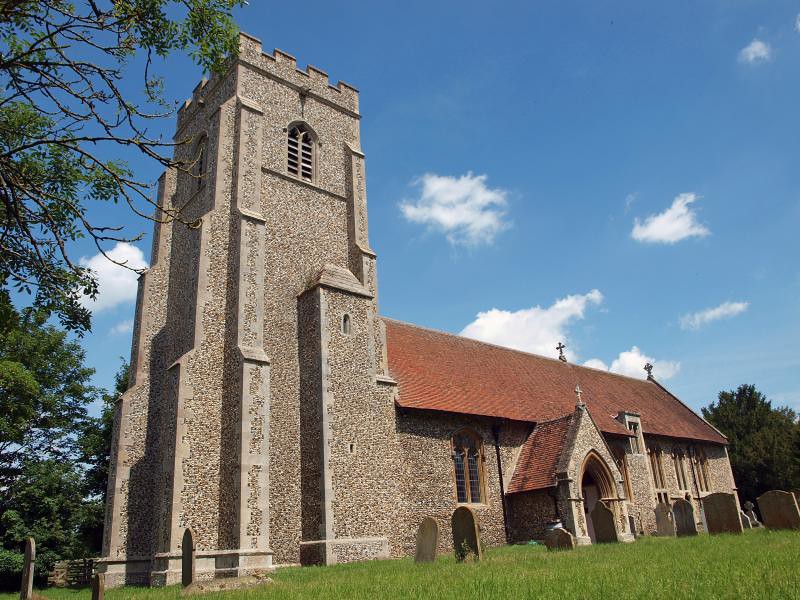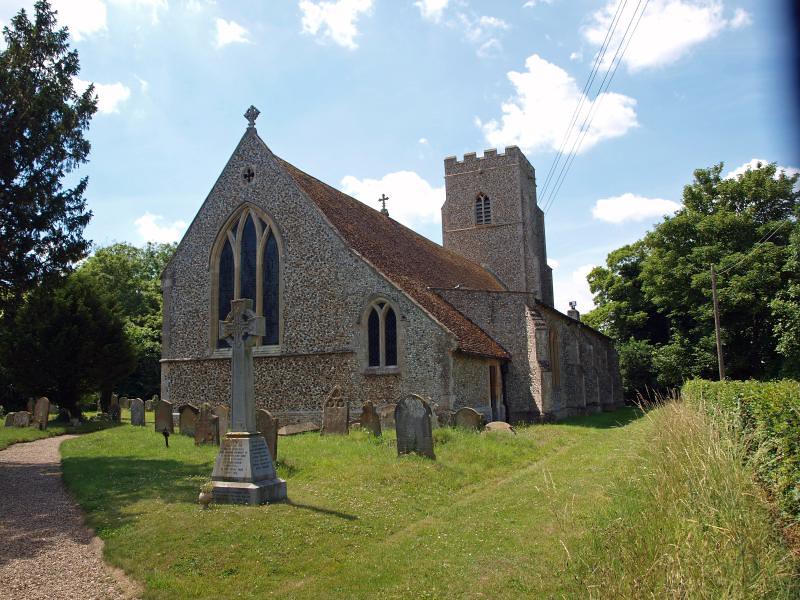ST ANDREW. Over-restored or rather rebuilt (by Street, 1867). W tower rebuilt 1884. One window with Y-tracery in the vestry, two two-light Perp windows used as a kind of dormer. E window of three stepped lancet lights under one arch, shafted inside, i.e. c. 1300. Arcade with piers of keeled quatrefoil section and arches with one chamfer and one recessed chamfer, i.e. also c. 1300. - Nice Perp canted wagon-roofs in nave and chancel, with bosses. - BENCH ENDS. With poppyheads, some in the form of kneeling figures, very pretty. - SCULPTURE. Alabaster relief from a former altar, a scene from the Life of St Eligius, C15.- PLATE. Elizabethan Cup; Paten 1723.
FRECKENHAM. It has an ancient windmill, a little bridge, and a group of delightful cottages, and it is proud to possess the oldest blacksmith in Suffolk, a jolly little man with a queer way all his own of shoeing a horse. He is in the church, which is nearly all old though it has a modern tower. Under a single roof are a 13th century chancel and a nave with a 15th century arcade. The chancel has a stone seat below one of its beautiful windows, and the nave an attractive dormer window. In the north aisle roof are 12 wooden corbels with odd faces, and much fine carving watched over by angels. Many of the pews are old oak with fragments of rich carving. There are poppyheads and odd little creatures, animals and birds, a nun praying and a monk on his knees, an angel with a scroll, and a surprising carving of a monkey holding a man upside down.
But it is the blacksmith we come to see, a charming figure in a small alabaster panel found when workmen were repairing the church in 1776. Quite how old he is is not known; he may have been at Freckenham about 600 years. He is thought to be St Eloy, the patron of blacksmiths, and it is said that when he shod a horse he would take away its leg into the smithy, make a shoe for it, and put the leg back, healing the animal by making the sign of the Cross. Here the old legend is quaintly carved for us, with St Eloy holding a horse’s leg on an anvil and a hammer in his hand. Close by is a horse with three legs, its little master wearing a kind of bonnet and looking rather anxious about the missing leg.
But it is the blacksmith we come to see, a charming figure in a small alabaster panel found when workmen were repairing the church in 1776. Quite how old he is is not known; he may have been at Freckenham about 600 years. He is thought to be St Eloy, the patron of blacksmiths, and it is said that when he shod a horse he would take away its leg into the smithy, make a shoe for it, and put the leg back, healing the animal by making the sign of the Cross. Here the old legend is quaintly carved for us, with St Eloy holding a horse’s leg on an anvil and a hammer in his hand. Close by is a horse with three legs, its little master wearing a kind of bonnet and looking rather anxious about the missing leg.


No comments:
Post a Comment